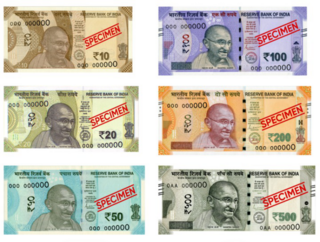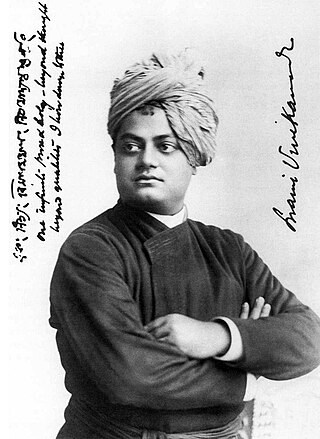
Transport in India consists of transport by land, water and air. Road transport is the primary mode of transport for most Indian citizens, and India's road transport systems are among the most heavily used in the world.

Rail transport in India consists of primarily of passenger and freight shipments along an integrated rail network. Indian Railways (IR), a statutory body under the ownership of the Ministry of Railways of the Government of India, operates India's national railway system. It is the primary owner and operator of rail operations throughout the country including suburban rail in major metros.

The Indian rupee is the official currency in India. The rupee is subdivided into 100 paise. The issuance of the currency is controlled by the Reserve Bank of India. The Reserve Bank manages currency in India and derives its role in currency management based on the Reserve Bank of India Act, 1934.

The Pakistani rupee is the official currency in the Islamic Republic of Pakistan. The issuance of the currency is controlled by the State Bank of Pakistan. It was officially adopted by the Government of Pakistan in 1949. Earlier the coins and notes were issued and controlled by the Reserve Bank of India until 1949, when it was handed over to the Government and State Bank of Pakistan, by the Government and Reserve Bank of India.

Indian Railways is a statutory body under the ownership of the Ministry of Railways of the Government of India that operates India's national railway system. As of 2023, it manages the fourth largest national railway system by size with a track length of 132,310 km (82,210 mi), running track length of 106,493 km (66,172 mi) and route length of 68,584 km (42,616 mi). As of August 2024, 96.59% of the broad-gauge network is electrified. With more than 1.2 million employees, it is the world's ninth-largest employer and India's second largest employer.

Coins of the Indian rupee (₹) were first minted in 1950. New coins have been produced annually since then and they make up a valuable aspect of the Indian currency system. Today, circulating coins exist in denominations of One Rupee, Two Rupees, Five Rupees, Ten Rupees and Twenty Rupees. All of these are produced by four mints located across India, in Kolkata, Mumbai, Hyderabad, Noida.

The India Government Mint, Mumbai is one of the four mints in India and is in the city of Mumbai. The mint was established in 1824 by the then governor of the Bombay Presidency. Its main activity is the production of commemorative and development-oriented coins. The mint is opposite the Reserve Bank of India in the Fort area of South Mumbai.

Namma Metro, also known as Bengaluru Metro, is a rapid transit system serving the city of Bengaluru, the capital city of the state of Karnataka, India. It is the second-longest operational metro network in India with an operational length of 76.95 kilometers, just behind Delhi Metro. Upon its inauguration in 2011, it became the first underground metro system in South India. Namma Metro has a mix of underground, at grade, and elevated stations. Out of the 68 operational metro stations of Namma Metro as of November 2024, there are 59 elevated stations, eight underground stations and one at-grade station. The system runs on standard-gauge tracks.

The history of the rupee traces back to ancient times in the Indian subcontinent. The mention of rūpya by Pāṇini is seemingly the earliest reference in a text about coins. The term in Indian subcontinent was used for referring to a coin.

The Indian Revenue Service, often abbreviated as IRS, is a civil service that is primarily responsible for collecting and administering direct and indirect taxes. As a central civil service under Group A of the executive branch of the Government of India, it functions under the Department of Revenue of the Ministry of Finance and is under the administrative direction of the Revenue Secretary and the ministerial command of the Minister of Finance.

The Central Organisation for Railway Electrification (CORE) is the unit of Indian Railways responsible for electrification of the network. The organisation, founded in 1979, is headquartered in Prayagraj, Uttar Pradesh. Project units operate in Ambala, Bangalore, Chennai, Secunderabad, Lucknow, Ahmedabad, Jaipur, Danapur, and New Jalpaiguri.

Secunderabad Junction is an NSG–1 category Indian railway station in Secunderabad railway division of South Central Railway zone. It is the major Railway Junction in the city of Hyderabad, Telangana, India. It is one of the busiest railway stations in South India and one of the most important hubs in the country and a commuter rail hub in the Hyderabad urban area. Built in 1874 by the Nizam of Hyderabad during the British era, it was the main station of Nizam's Guaranteed State Railway until the Kacheguda railway station opened in 1916. The station was taken over by Indian Railways in 1951, when NGSR was nationalised. Its main portico and concourse are influenced by Nizamesque architecture. The station, which resembles a fort, is a tourist attraction in the twin cities of Hyderabad and Secunderabad.

Bengaluru Suburban Railway is an under-construction suburban rail network for the city of Bangalore. A suburban rail system for the city was first proposed in 1983. Since then, several different route proposals were made but no suburban rail project took shape. It was finally approved in the 2019 Railway Budget.
Central Secretariat Service is the administrative civil service under Group A and Group B of the Central Civil Services of the executive branch of the Government of India. They are governed by Central Secretariat Service Rules of 1962, which has been issued under the powers of Article 309 of the Constitution of India. The service members work under restrictions and rules of Central Civil Services (Conduct) Rules.

Udaya Kumar Dharmalingam is an Indian academic and designer noted for his design of the Indian rupee sign. His design was selected from among five short listed symbols. According to Kumar, the design is based on the Indian tricolour.
The Indian rupee sign ⟨₹⟩ is the currency symbol for the Indian rupee, the official currency of India. Designed by D. Udaya Kumar, it was presented to the public by the Government of India on 15 July 2010, following its selection through an open competition among Indian residents. Before its adoption, the most commonly used symbols for the rupee were ⟨Rs⟩, ⟨Re⟩ or, in texts in Indian languages, an appropriate abbreviation in the language used.

Vivek Express refers to multiple related express trains on the Indian Railways network. These services were launched in 2013 to commemorate the 150th birth anniversary of Swami Vivekananda. One of the Vivek Express trains, the one from Dibrugarh to Kanyakumari, is the longest route on the Indian Railways network, in terms of distance and time, and is currently the 28th longest in the world.

Swami Vivekananda was an Indian Hindu monk. He was a key figure in the introduction of the Indian philosophies of Vedanta and Yoga to the western world. The 150th birth anniversary of Swami Vivekananda was celebrated all over India and in different countries in the world. Ministry of Youth Affairs & Sports of India decided to observe 2013 as the year of 150th Birth Anniversary of Swami Vivekananda. Year-long events and programs were organised by different branches of Ramakrishna Math, Ramakrishna Mission, central government and different state governments of India, education institutions, youth groups etc. Bengali film director Tutu (Utpal) Sinha made a film The Light: Swami Vivekananda as a tribute to Swami Vivekananda on his 150th birth anniversary. The movie was released on 23 August 2013.

The Indian Revenue Service (Income Tax) (IAST: Bhāratīya Rājasva Sevā), often abbreviated as IRS (IT), is the administrative revenue service of the Government of India. As a Central Service, it functions under the Department of Revenue of the Ministry of Finance and is under the administrative direction of the Revenue Secretary and the ministerial command of the Minister of Finance. The IRS is primarily responsible for collecting and administering direct taxes accruing to the Government of India.
















